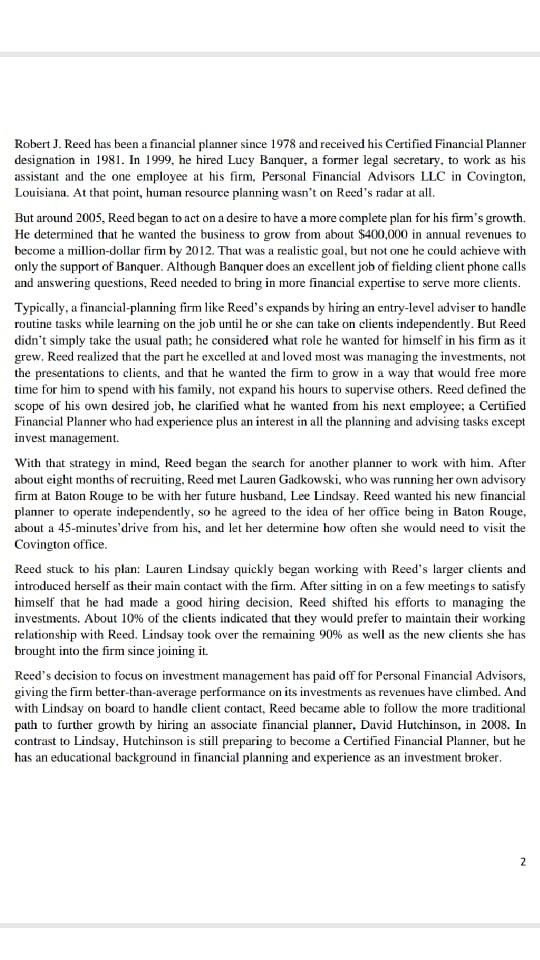Can you specify the answer of these question from the Robert J Reed's case study? First picture has the questions, Second picture has the case.
Robert J. Reed has been a financial planner since 1978 and received his Certified Financial Planner designation in 1981. In 1999, he hired Lucy Banquer, a former legal secretary, to work as his assistant and the one employee at his firm. Personal Financial Advisors LLC in Covington, Louisiana. At that point, human resource planning wasn't on Reed's radar at all. But around 2005. Reed began to act on a desire to have a more complete plan for his firm's growth. He determined that he wanted the business to grow from about $400,000 in annual revenues to become a million-dollar firm by 2012. That was a realistic goal, but not one he could achieve with only the support of Banquer. Although Banquer does an excellent job of fielding client phone calls and answering questions, Reed needed to bring in more financial expertise to serve more clients. Typically, a financial-planning firm like Reed's expands by hiring an entry-level adviser to handle routine tasks while learning on the job until he or she can take on clients independently. But Reed didn't simply take the usual path; he considered what role he wanted for himself in his firm as it grew. Reed realized that the part he excelled at and loved most was managing the investments, not the presentations to clients, and that he wanted the firm to grow in a way that would free more time for him to spend with his family, not expand his hours to supervise others. Reed defined the scope of his own desired job, he clarified what he wanted from his next employee; a Certified Financial Planner who had experience plus an interest in all the planning and advising tasks except invest management. With that strategy in mind, Reed began the search for another planner to work with him. After about eight months of recruiting, Reed met Lauren Gadkowski, who was running her own advisory firm at Baton Rouge to be with her future husband, Lee Lindsay. Reed wanted his new financial planner to operate independently, so he agreed to the idea of her office being in Baton Rouge, about a 45-minutes'drive from his, and let her determine how often she would need to visit the Covington office. Reed stuck to his plan: Lauren Lindsay quickly began working with Reed's larger clients and introduced herself as their main contact with the firm. After sitting in on a few meetings to satisfy himself that he had made a good hiring decision, Reed shifted his efforts to managing the investments. About 10% of the clients indicated that they would prefer to maintain their working relationship with Reed. Lindsay took over the remaining 90% as well as the new clients she has brought into the firm since joining it. Reed's decision to focus on investment management has paid off for Personal Financial Advisors, giving the firm better-than-average performance on its investments as revenues have climbed. And with Lindsay on board to handle client contact, Reed became able to follow the more traditional path to further growth by hiring an associate financial planner, David Hutchinson, in 2008. In contrast to Lindsay, Hutchinson is still preparing to become a Certified Financial Planner, but he has an educational background in financial planning and experience as an investment broker, 22 Questions Total Marks: 10 1. Is a company ever too small for the need to engage in human resource planning? Why or why not? Discuss whether you think Robert Reed planned his hiring strategy at an appropriate time in the firm's growth. (3) 2. Using the table provided below, review the options for avoiding a labor shortage, and discuss how well the options besides new hires could have worked for Reed to reach his goals for growth. As you do so, consider qualities of a financial-planning business that might be relevant (for example, direct client contact and the need for confidentiality). (3) 3. Suppose that when Reed was seeking to hire a certified financial planner, he asked you for advice on where to recruit this person. Which sources would you suggest, and why? (4) Options for Reducing a Surplus Options for Avoiding a Shortage Downsizing Overtime Pay reductions Temporary employees Demotions Outsourcing Tansfers Retrained transfers Work Sharing Turnover reductions Hiring freeze New external hires Natural attrition Technological innovation Early retirement Retraining Table: HR Strategies for addressing a Labor Shortage or Surplus 3








